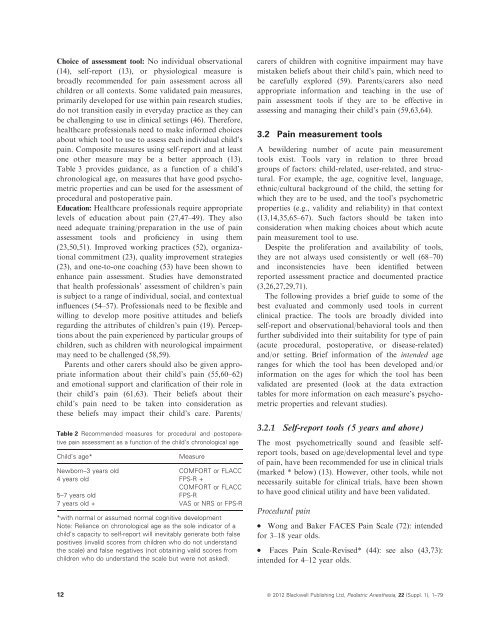Good Practice in Postoperative and Procedural Pain Management ...
Good Practice in Postoperative and Procedural Pain Management ...
Good Practice in Postoperative and Procedural Pain Management ...
Create successful ePaper yourself
Turn your PDF publications into a flip-book with our unique Google optimized e-Paper software.
Choice of assessment tool: No <strong>in</strong>dividual observational(14), self-report (13), or physiological measure isbroadly recommended for pa<strong>in</strong> assessment across allchildren or all contexts. Some validated pa<strong>in</strong> measures,primarily developed for use with<strong>in</strong> pa<strong>in</strong> research studies,do not transition easily <strong>in</strong> everyday practice as they canbe challeng<strong>in</strong>g to use <strong>in</strong> cl<strong>in</strong>ical sett<strong>in</strong>gs (46). Therefore,healthcare professionals need to make <strong>in</strong>formed choicesabout which tool to use to assess each <strong>in</strong>dividual child’spa<strong>in</strong>. Composite measures us<strong>in</strong>g self-report <strong>and</strong> at leastone other measure may be a better approach (13).Table 3 provides guidance, as a function of a child’schronological age, on measures that have good psychometricproperties <strong>and</strong> can be used for the assessment ofprocedural <strong>and</strong> postoperative pa<strong>in</strong>.Education: Healthcare professionals require appropriatelevels of education about pa<strong>in</strong> (27,47–49). They alsoneed adequate tra<strong>in</strong><strong>in</strong>g/preparation <strong>in</strong> the use of pa<strong>in</strong>assessment tools <strong>and</strong> proficiency <strong>in</strong> us<strong>in</strong>g them(23,50,51). Improved work<strong>in</strong>g practices (52), organizationalcommitment (23), quality improvement strategies(23), <strong>and</strong> one-to-one coach<strong>in</strong>g (53) have been shown toenhance pa<strong>in</strong> assessment. Studies have demonstratedthat health professionals’ assessment of children’s pa<strong>in</strong>is subject to a range of <strong>in</strong>dividual, social, <strong>and</strong> contextual<strong>in</strong>fluences (54–57). Professionals need to be flexible <strong>and</strong>will<strong>in</strong>g to develop more positive attitudes <strong>and</strong> beliefsregard<strong>in</strong>g the attributes of children’s pa<strong>in</strong> (19). Perceptionsabout the pa<strong>in</strong> experienced by particular groups ofchildren, such as children with neurological impairmentmay need to be challenged (58,59).Parents <strong>and</strong> other carers should also be given appropriate<strong>in</strong>formation about their child’s pa<strong>in</strong> (55,60–62)<strong>and</strong> emotional support <strong>and</strong> clarification of their role <strong>in</strong>their child’s pa<strong>in</strong> (61,63). Their beliefs about theirchild’s pa<strong>in</strong> need to be taken <strong>in</strong>to consideration asthese beliefs may impact their child’s care. Parents/Table 2 Recommended measures for procedural <strong>and</strong> postoperativepa<strong>in</strong> assessment as a function of the child’s chronological ageChild’s age*MeasureNewborn–3 years oldCOMFORT or FLACC4 years old FPS-R +COMFORT or FLACC5–7 years old FPS-R7 years old + VAS or NRS or FPS-R*with normal or assumed normal cognitive developmentNote: Reliance on chronological age as the sole <strong>in</strong>dicator of achild’s capacity to self-report will <strong>in</strong>evitably generate both falsepositives (<strong>in</strong>valid scores from children who do not underst<strong>and</strong>the scale) <strong>and</strong> false negatives (not obta<strong>in</strong><strong>in</strong>g valid scores fromchildren who do underst<strong>and</strong> the scale but were not asked).carers of children with cognitive impairment may havemistaken beliefs about their child’s pa<strong>in</strong>, which need tobe carefully explored (59). Parents/carers also needappropriate <strong>in</strong>formation <strong>and</strong> teach<strong>in</strong>g <strong>in</strong> the use ofpa<strong>in</strong> assessment tools if they are to be effective <strong>in</strong>assess<strong>in</strong>g <strong>and</strong> manag<strong>in</strong>g their child’s pa<strong>in</strong> (59,63,64).3.2 Pa<strong>in</strong> measurement toolsA bewilder<strong>in</strong>g number of acute pa<strong>in</strong> measurementtools exist. Tools vary <strong>in</strong> relation to three broadgroups of factors: child-related, user-related, <strong>and</strong> structural.For example, the age, cognitive level, language,ethnic/cultural background of the child, the sett<strong>in</strong>g forwhich they are to be used, <strong>and</strong> the tool’s psychometricproperties (e.g., validity <strong>and</strong> reliability) <strong>in</strong> that context(13,14,35,65–67). Such factors should be taken <strong>in</strong>toconsideration when mak<strong>in</strong>g choices about which acutepa<strong>in</strong> measurement tool to use.Despite the proliferation <strong>and</strong> availability of tools,they are not always used consistently or well (68–70)<strong>and</strong> <strong>in</strong>consistencies have been identified betweenreported assessment practice <strong>and</strong> documented practice(3,26,27,29,71).The follow<strong>in</strong>g provides a brief guide to some of thebest evaluated <strong>and</strong> commonly used tools <strong>in</strong> currentcl<strong>in</strong>ical practice. The tools are broadly divided <strong>in</strong>toself-report <strong>and</strong> observational/behavioral tools <strong>and</strong> thenfurther subdivided <strong>in</strong>to their suitability for type of pa<strong>in</strong>(acute procedural, postoperative, or disease-related)<strong>and</strong>/or sett<strong>in</strong>g. Brief <strong>in</strong>formation of the <strong>in</strong>tended ageranges for which the tool has been developed <strong>and</strong>/or<strong>in</strong>formation on the ages for which the tool has beenvalidated are presented (look at the data extractiontables for more <strong>in</strong>formation on each measure’s psychometricproperties <strong>and</strong> relevant studies).3.2.1 Self-report tools (5 years <strong>and</strong> above)The most psychometrically sound <strong>and</strong> feasible selfreporttools, based on age/developmental level <strong>and</strong> typeof pa<strong>in</strong>, have been recommended for use <strong>in</strong> cl<strong>in</strong>ical trials(marked * below) (13). However, other tools, while notnecessarily suitable for cl<strong>in</strong>ical trials, have been shownto have good cl<strong>in</strong>ical utility <strong>and</strong> have been validated.<strong>Procedural</strong> pa<strong>in</strong>l Wong <strong>and</strong> Baker FACES Pa<strong>in</strong> Scale (72): <strong>in</strong>tendedfor 3–18 year olds.l Faces Pa<strong>in</strong> Scale-Revised* (44): see also (43,73):<strong>in</strong>tended for 4–12 year olds.12 ª 2012 Blackwell Publish<strong>in</strong>g Ltd, Pediatric Anesthesia, 22 (Suppl. 1), 1–79
















